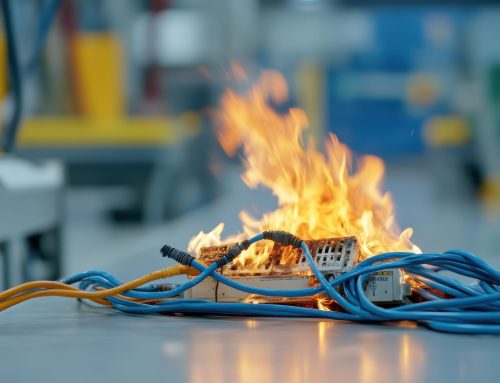 Clean agent suppression systems are activated by smoke rather than heat. As a result, clean agent systems are able to suppress fire at its incipient stage by dispersing either an inert or Hydrofluorocarbon(HFC) gas. Clean agents also prevent re-ignition.
Clean agent suppression systems are activated by smoke rather than heat. As a result, clean agent systems are able to suppress fire at its incipient stage by dispersing either an inert or Hydrofluorocarbon(HFC) gas. Clean agents also prevent re-ignition.
Clean agent suppression systems are specifically beneficial to buildings holding mission critical data such as telecommunication switches, server rooms, museums, vaults, or process control rooms. This is because when clean agent systems are used to extinguish fire, instead of sprinkler systems, there’s no concern over water damage.
Benefits of clean agent suppression systems
Beyond the obvious benefit that clean agents will not cause water damage, there are many other benefits to this type of automatic fire suppression system.
When designed properly, clean agent suppression systems pose no danger to personnel, have zero ozone depletion potential, and leave behind no residue. Clean agents are also highly effective at reaching obscure areas water may not penetrate.
Many businesses with mission critical data choose clean agent suppression systems as a more efficient, cleaner, and safer way to protect valuable assets that could be easily damaged by other methods of fire suppression.
Clean agent systems discharge in seconds with no clean up and minimal down time required. These types of suppression systems are also safe for use in occupied spaces.
Types of clean agent suppression systems
There are two types of gases stored used in clean agent systems: Hydrofluorocarbon (HFC) gases and inert gasses.HFCs are manufactured gases while inert gases are naturally occurring (i.e. nitrogen, argon, and carbon dioxide).
Each gas extinguishes fire in different ways. Inert gasses smother flames by reducing the oxygen content in the room while FM-200 or HFCs extinguish fires through a combination of chemical and physical mechanisms.
Each system has varying characteristics, but all clean agents extinguish fire without the need for water.

Developed by Ansul, Inc.; a nitrogen/argon/carbon dioxide mix that lowers the oxygen supply necessary for combustion. This clean agent is the only one stored as a gas.

A clean agent that uses HFC agents (HFC-227ea and FM-200) to extinguish fire through a series of chemical and physical mechanisms. Like other manufactured gases, it’s stored as a liquid.

An alternative to Halon 1301/FM-200, this agent is a colorless fire suppression fluid (Fluoroketone) that’s pressurized with nitrogen 360psi, and also stored as a liquid.
How do clean agent suppression systems work?
Clean agents are stored in cylinders as either liquid or highly pressurized gas. These cylinders are stored separately from the area they are meant to protect and are connected through a piping network that connects a system of nozzles.
When heat or smoke is detected, an electronic signal is sent to the control unit to send the clean agent gas through the cylinders and piping network. Once discharged, the system’s nozzles open as deflector shields work to direct the clean agent toward the fire.
In addition to the fire alarm sounding, just before discharge of the clean agent, in most cases the HVAC system will shut down and all fire doors will automatically close.
Which clean agent is best for my business?
The overall characteristics of clean agent suppression systems are appealing, and even necessary, for many businesses. When choosing the best clean agent system for your business, consider the varying characteristics of each clean agent.
- Environmental impact: All clean agents are safe for the environment, but Inergen is the greenest choice for its use of naturally occurring gasses.
- Floor space:While all clean agents are stored in cylinders, FM-200 requires minimal storage space since the agent is stored as a gas. Inergen, which is stored as a liquid, requires additional cylinders.
- Ventilation:If a clean agent, like Inergen, is stored at high pressure, it’s best if used in buildings with adequate ventilation.
- Proximity of tanks: Some clean agent cylinders can be stored further away from the room in which they protect, while others, like FM-200, need to be stored in closer proximity.
- Visibility after discharge: Most clean agents are barely if at all visible when discharged, but some like Novec 1230 can cause some lowered visibility.
What are the inspection & maintenance requirements for clean agent systems?
All clean agent suppression systems are required to be inspected and tested at least semi-annually.An external visual inspection is required at least every 5 years as long as cylinders are not discharged and in good working order.
Upon semi-annual inspections, a licensed technician will check the agent quantity and pressure of refillable containers.
For HFC clean agents, if a container shows a loss in agent quantity of more than 5 percent or loss in pressure of more than 10 percent, the agent will be refilled or replaced. For an inert gas clean agent to be refilled/replaced, it must show a loss in pressure of more than 5 percent.
Why is Fire Systems, Inc. the best choice for clean agent suppression systems?
The state of Georgia requires that any company involved in the inspection, testing, recharge or installation of special hazard systems must have at least one employee with a NICET level III in special hazard suppression systems. Technicians must show successful completion of NICET level II.
Fire Systems, Inc. is experienced and mindful of the certifications, permits, and requirements demanded by local building, fire departments, and insurance providers. This is why all of our technicians hold the required licenses and NICET level training to install, inspect, and maintain your clean agent suppression system.
Fire Systems, Inc. has decades of experience servicing all types of fire suppression systems including CO2, Halon, and FM-200. Call Fire Systems, Inc. today or visit our websitefor more information.






